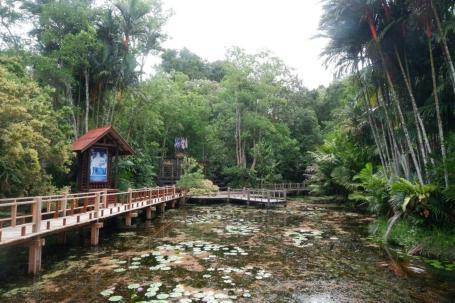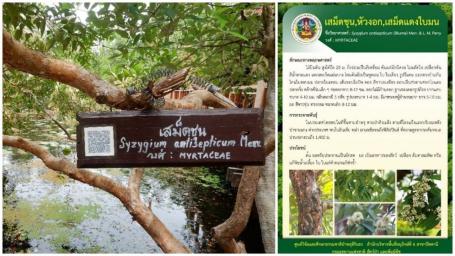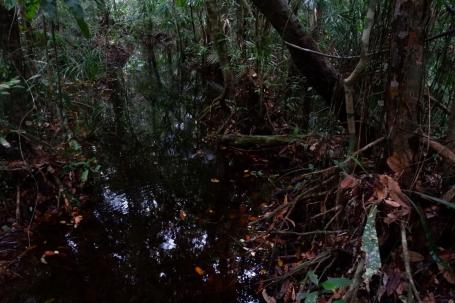
The Jewel of Southern Thailand: Toh Daeng Peat Swamp Forest
Thailand might not have a vast area of tropical peatlands as its Southeast Asian neighbors like Indonesia and Malaysia. It only covers about 60,331 ha of land, much smaller compared to Indonesia, where 13.43 million hectares of peatlands can be found. However, it doesn't mean that peatlands in Thailand are not important since this type of wetland offers numerous ecosystem services.
Besides its important role as the source of food and medicinal plants for communities, peatlands also have an essential role in water management (including as a freshwater source, flood control, and prevention of saline intrusion) and supporting large biodiversity within their ecosystems. Most importantly, peatlands play an important role in the global carbon cycle, storing vast amounts of carbon in the ground, and are subsequently one of the world's most valuable ecosystems with regard to helping tackle climate change.
The Toh Daeng peat swamp forest is Thailand's last remaining pristine peat swamp forest, with a total area of 123,006 rai1 or 19,681 hectares, with around 40% of the area (8,000 hectares) are dense forests. This area spreads over three districts, including Tak Bai, Su-ngai Kolok, and Su-ngai Padi, in Narathiwat Province. The People for Peat (PFP) under the Sustainable Use of Peatland and Haze Mitigation in ASEAN (EU-SUPA) Component 2 Programme, a coalition to enhance the participation of non-state actors in sustainable use and management of peatlands across the ASEAN region including Thailand, were visiting the peat swamp forest area in June 2022. After an hour flight from Bangkok to Hatyai and two hours car ride from Hat Yai to Phatthalung, we needed around 5 hours by car to visit this area from Thale Noi, another peat swamp area we visited in Phatthalung Province, Thailand. During the visit, we had a chance to discuss the current condition and management of peatland in the Toh Daeng peat swamp forest with the Sirindhorn Peat Swamp Forest Nature Research and Study Centre director, Mr. Pleecheep.

Considering that peatland has unique characteristics as well as direct and indirect benefits for the people living surround it, the government has taken real action to protect the remaining peatlands in the country. Along with the peatland in Thale Noi of Phatthalung Province and in Khuan Khreng Landscape of Nakhon Si Thammarat Province that has been designated as a non-hunting area, the government also declared the Toh Daeng peat swamp forest as a wildlife sanctuary area. Mr. Pleecheep also mentioned that the local ecosystems in the Toh Daeng peat swamp forest are also studied to develop long-term conservation, restoration, and management plans in the area.
Furthermore, through the Sirindhorn Peat Swamp Forest Nature Research and Study Centre, the government also supports communications, outreach, and advocacy activities to increase the knowledge and awareness of peat swamp forests to a broader audience. To reach that goal, they provided study treks to transfer knowledge on peat swamp forests to visitors. There is also a high tower for viewing the peat swamp forest area from above and an exhibition room where visitors can find more information.
The PFP team experienced the 1,200-meter trail, which starts from a swamp behind the Centre. We found breath-taking peat swamp forest scenery with relaxing birds and other animal sounds along the way. We also saw many informative boards that provided interesting facts about trees and animals living in the area. Unfortunately, we couldn't reach the peat soil and measure the peat depth directly because we were only allowed to explore the area through the trail. Still, Mr. Pleecheep and the informative board provided showed that the peatland in this area is 0.5 to 5 meters deep.

Toh Daeng Peat Swamp Forest is also rich in biodiversity. There are over 500 species of vegetation, including large standing trees, bushes, climbers, and lower species like moss, lichens, and fungi. This makes Toh Daeng peat swamp forests a large center of wetland plant diversity. Jelutong or Dyera costulata (family of Apocynaceae), one of the peatland's native plants, can be found in this area. Plants from the family of Myrtaceae can also easily be found in this area, such as Syzygium antisepticum Merr. (shore eugenia) and Syzygium pyrifolium (Blume) DC. Other plant families, like Annonaceae, Lauraceae, Malvaceae, Pandanaceae, and many more, are also part of the peat swamp forest's richness. The Sirindhorn Peat Swamp Forest Nature Research and Study Centre offered a fun way to know the type of plants we found in the area. They provide a barcode for each plant, along with a Thai and scientific name. Interestingly, we can scan the barcode that leads us to a link containing a downloadable .jpg file with information about the plant. Unfortunately, the information is only available in Thai.

The Toh Daeng peat swamp forest is also home to various animals, with almost 300 animal species living in the area. Based on the data provided by the Centre, there are 14 species of amphibians, 30 species of reptiles, 195 species of birds (including woodpeckers and hornbills), 50 species of mammals (including sun bear, wild boar, black panther, monkeys, and bats), several species of insects, spiders and other invertebrates live in the peat swamp forest. A variety of fish also makes it home in the forest, including a certain species of catfish that can be raised in acidic water. The other aquatic species that are commonly found in the area are the snakehead fish, eel, and several new species discovered in peat swamp forests. The fish uses the forest as a refuge and to spawn. Villagers catch this fish for food when it is fully grown.

It is widely known that, due to a lack of awareness, peat swamp forests are encroached on and have undergone rapid destruction and degradation. Activities like timber harvesting, peat burning, and land clearing for agricultural and other purposes have led to peatland degradation in many countries. These experiences from other countries are a huge opportunity for the Thai government and people to learn that by protecting the country's last remaining pristine peat swamp forest. It will ensure the country's next generation can experience the unique and essential ecosystem called "pristine peat swamp forest".